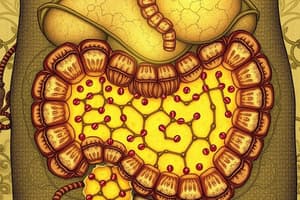Podcast
Questions and Answers
What is the primary function of mechanical digestion?
What is the primary function of mechanical digestion?
- To absorb nutrients into the bloodstream
- To transport nutrients to various cells
- To physically break down food and increase surface area (correct)
- To chemically break down food using enzymes
Which type of nutrient is absorbed as amino acids?
Which type of nutrient is absorbed as amino acids?
- Proteins (correct)
- Vitamins
- Carbohydrates
- Lipids
What role do enzymes play in chemical digestion?
What role do enzymes play in chemical digestion?
- They absorb nutrients into the bloodstream
- They transport nutrients across cell membranes
- They break down complex molecules into simpler ones (correct)
- They physically alter the structure of food
Which of the following transport mechanisms requires energy?
Which of the following transport mechanisms requires energy?
Which enzyme is specifically responsible for the breakdown of carbohydrates?
Which enzyme is specifically responsible for the breakdown of carbohydrates?
Where does the primary absorption of nutrients occur?
Where does the primary absorption of nutrients occur?
Which nutrient is absorbed as fatty acids and glycerol?
Which nutrient is absorbed as fatty acids and glycerol?
What is the purpose of facilitated diffusion in nutrient transport?
What is the purpose of facilitated diffusion in nutrient transport?
Flashcards
Digestion
Digestion
Breaking down large food molecules into smaller, absorbable molecules.
Absorption
Absorption
Taking up digested nutrients from the alimentary canal into the bloodstream or lymph.
Mechanical Digestion
Mechanical Digestion
Physical breakdown of food to increase surface area for chemical digestion.
Chemical Digestion
Chemical Digestion
Signup and view all the flashcards
Nutrient Absorption (Small intestine)
Nutrient Absorption (Small intestine)
Signup and view all the flashcards
Carbohydrate Absorption
Carbohydrate Absorption
Signup and view all the flashcards
Active Transport
Active Transport
Signup and view all the flashcards
Amylase
Amylase
Signup and view all the flashcards
Study Notes
Digestion, Absorption, and Transport
-
Digestion is the breakdown of large, insoluble food molecules into smaller, water-soluble molecules that can be absorbed into the bloodstream. This process occurs in the alimentary canal.
-
Mechanical digestion involves physical breakdown of food, increasing the surface area for chemical digestion. This includes chewing (mastication) and churning of food in the stomach.
-
Chemical digestion involves the use of enzymes to break down large complex molecules into smaller simpler molecules for absorption. This includes the action of enzymes like amylase, protease, and lipase.
Nutrient Absorption
-
Nutrient absorption is the process by which the products of digestion are taken up from the alimentary canal into the bloodstream or lymphatic system.
-
This absorption primarily occurs in the small intestine.
-
Different nutrients are absorbed by different mechanisms, influenced by their chemical structure.
Types of Nutrient Absorption
- Carbohydrates are absorbed as monosaccharides (e.g., glucose).
- Proteins are absorbed as amino acids.
- Lipids are absorbed as fatty acids and glycerol.
Chemical Digestion
- Chemical digestion involves breaking down complex food molecules into smaller, simpler molecules using enzymes.
- Different enzymes are used for different nutrients:
- Amylase breaks down carbohydrates.
- Proteases break down proteins.
- Lipases break down lipids.
- Enzymes are highly specific in their action; each enzyme works on only a particular type of molecule.
- The enzymes' activity is affected by factors like pH and temperature.
Transport Mechanisms
- Once absorbed, nutrients need to be transported to different parts of the body for utilization.
- Different transport mechanisms exist depending on the nutrient's chemical nature and the site of absorption.
- Simple diffusion involves passively moving molecules across a concentration gradient.
- Facilitated diffusion uses carrier proteins for moving molecules across a membrane.
- Active transport requires energy to transport molecules against the concentration gradient.
- Lymphatic system plays a crucial role in transporting fat-soluble vitamins and lipids.
- Bloodstream carries water-soluble nutrients to various cells and tissues for utilization, storage, or further metabolism.
Summary of Digestion Processes
- Mouth: Mechanical digestion (chewing) begins, and salivary amylase initiates chemical digestion of starch.
- Stomach: Mechanical digestion (churning) continues, and protein digestion by pepsin begins.
- Small intestine: Major site of chemical digestion and absorption. Enzymes from the pancreas and the small intestine complete the breakdown of carbohydrates, proteins, and fats. The products of digestion are absorbed into the bloodstream.
- Large intestine: Absorbs water and electrolytes, forming feces.
- Rectum and anus: Feces are eliminated from the body.
Studying That Suits You
Use AI to generate personalized quizzes and flashcards to suit your learning preferences.




